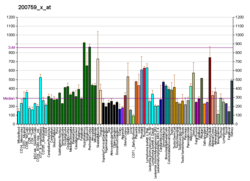Cellular homeostasis
NFE2L1 regulates a wide variety of cellular responses, several of which are related to important aspects of protection from stress stimuli. NFE2L1 is involved in providing cellular protection against oxidative stress through the induction of antioxidant genes. The glutathione synthesis pathway is catalyzed by glutamate-cysteine ligase, which contains the catalytic GCLC and regulatory GCLM, and glutathione synthetase (GSS). [15] NFE2L1 was found to regulate Gclm and Gss expression in mouse fibroblasts. [16] Gclm was found to be a direct target of NFE2L1. NFE2L1 also regulates Gclc expression through an indirect mechanism. [17] [18] NFE2L1 knockout mice also exhibit down-regulation of Gpx1-, Hmox1-, and NFE2L1-deficient hepatocytes from liver-specific NFE2L1 knockout mice showed decreased expression of various Gst genes. [19] [20] Metallothioenein-1 and Metallothioenein-2 genes, which protect cells against cytotoxicity induced by toxic metals, are also direct targets of NFE2L1. [21]
NFE2L1 is also involved in maintaining proteostasis. Brains of mice with conditional knockout of NFE2L1 in neuronal cells showed decreased proteasome activity and accumulation of ubiquitin-conjugated proteins, and down regulation of genes encoding the 20S core and 19S regulatory sub-complexes of the 26S proteasome. [22] A similar effect on proteasome gene expression and function was observed in livers of mice with NFE2L1 conditional knockout in hepatocytes. [23] Induction of proteasome genes was also lost in brains and livers of NFE2L1 conditional knockout mice. Re-establishment of NFE2L1 function in NFE2L1 null cells rescued proteasome expression and function, indicating NFE2L1 was necessary for induction of proteasome genes (bounce-back response) in response to proteasome inhibition. [24] This compensatory up-regulation of proteasome genes in response to proteasome inhibition has also been demonstrated to be NFE2L1-dependent in various other cell types. [25] [26] NFE2L1 was shown to directly bind and activate expression of the PsmB6 gene, which encodes a catalytic subunit of the 20S core. [22] [24] In the retina, it was shown that NFE2L1 overexpression increases and knockout reduces proteasomal levels and activity. [27] NFE2L1 was also shown to regulate expression of Herpud1 and Vcp/p97, which are components of the ER-associated degradation pathway. [28] [26]
NFE2L1 also plays a role in metabolic processes. Loss of hepatic NFE2L1 has been shown to result in lipid accumulation, hepatocellular damage, cysteine accumulation, and altered fatty acid composition. [20] [29] Glucose homeostasis and insulin secretion have also been found to be under the control of NFE2L1. [30] Insulin-regulated glycolytic genes—Gck, Aldob, Pgk1, and Pklr, hepatic glucose transporter gene — SLC2A2, and gluconeogenic genes — Fbp1 and Pck1 were repressed in livers of NFE2L1 transgenic mice. [31] NFE2L1 may also play a role in maintaining chromosomal stability and genomic integrity by inducing expression of genes encoding components of the spindle assembly and kinetochore. [32] NFE2L1 has also been shown to sense and respond to excess cholesterol in the ER. [11]
Regulation
NFE2L1 is an ER membrane protein. Its N-terminal domain (NTD) anchors the protein to the membrane. Specifically, amino acid residues 7 to 24 are known to be a hydrophobic domain that serves as a transmembrane region. [33] The concerted mechanism of HRD1, a member of E3-ubiquitin ligase family, and p97/VCP1 was found to play an important role in the degradation of NFE2L1 through the ER Associated Degradation (ERAD) pathway and the release of NFE2L1 from the ER membrane. [25] [34] [35] NFE2L1 is also regulated by other ubiquitin ligases and kinases. FBXW7, a member of the SCF ubiquitin ligase family, targets NFE2L1 for proteolytic degradation by the proteasome. [36] FBXW7 requires the Cdc4 phosphodegron domain within NFE2L1 to be phosphorylated via Glycogen Kinase 3. [37] Casein Kinase 2 was shown to phosphorylate Ser497 of NFE2L1, which attenuates the activity of NFE2L1 on proteasome gene expression. [38] NFE2L1 also interacts with another member of the SCF ligase ubiquitin family known as β-TrCP. β-TrCP also binds to the DSGLC motif, a highly conserved region of CNC-bZIP proteins, in order to polyubiquitinate NFE2L1 prior to its proteolytic degradation. [34] Phosphorylation of Ser599 by protein kinase A enables NFE2L1 and C/EBP-β to dimerize to repress DSPP expression during odontoblast differentiation. [39] NFE2L1 expression and activation is also controlled by cellular stresses. Oxidative stress induced by arsenic and t-butyl hydroquinone leads to accumulation of the NFE2L1 protein inside the nucleus as well as higher activation on antioxidant genes. [9] [40] Treatment with an ER stress inducer, tunicamycin, was shown to induce accumulation of NFE2L1 inside the nucleus; however, it was not associated with increased activity, suggesting further investigation is needed to explain the role of ER stress on NFE2L1. [41] [9] Hypoxia was also shown to increase the expression of NFE2L1 while attenuating expression of the p65 isoform of NFE2L1. [42] Growth factors affect expression of NFE2L1 through an mTORC and SREBP-1 mediated pathway. Growth factors induce higher activity of mTORC, which then promotes activity of its downstream protein SREBP-1, a transcription factor for NFE2L1. [43] [44]
This page is based on this
Wikipedia article Text is available under the
CC BY-SA 4.0 license; additional terms may apply.
Images, videos and audio are available under their respective licenses.






